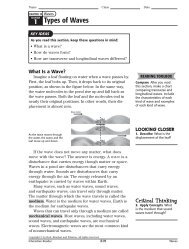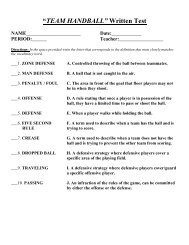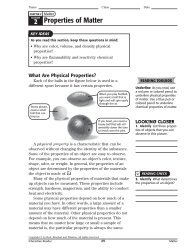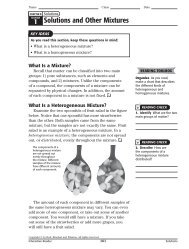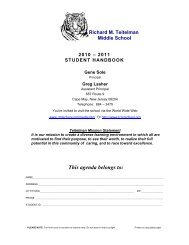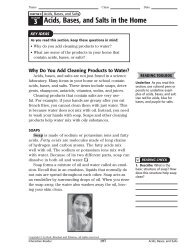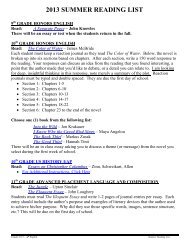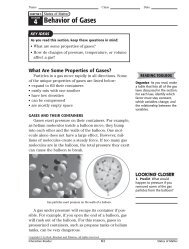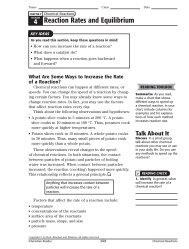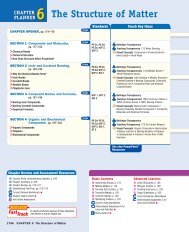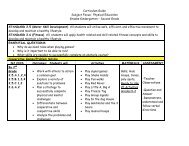16.3 Reflection and Color Interactive Guide
16.3 Reflection and Color Interactive Guide
16.3 Reflection and Color Interactive Guide
You also want an ePaper? Increase the reach of your titles
YUMPU automatically turns print PDFs into web optimized ePapers that Google loves.
Name Class DateCHAPTER 1613SECTIONSound <strong>and</strong> Light<strong>Reflection</strong> <strong>and</strong> <strong>Color</strong>KEY IDEASAs you read this section, keep these questions in mind:• What happens to light when it hits an object?• Why can you see an image in a mirror?• Why do we see colors?What Happens When Light Hits an Object?You may think of light bulbs, c<strong>and</strong>les, <strong>and</strong> the sun asobjects that send light to your eyes. However, all of theother objects that you see, including this book, also sendlight to your eyes. Otherwise, you would not see them. Inorder for you to see an object, light must travel from theobject to your eyes.There are two main ways that light can get from anobject to your eyes. Some objects, such as the sun ora light bulb, produce light. However, most objects,including this book, only reflect light from other sources.LIGHT AS A RAYIt can be hard to imagine how light waves travel. Tomake it easier to underst<strong>and</strong> <strong>and</strong> predict how light wavesbehave during reflection, refraction, <strong>and</strong> other processes,scientists use light rays.A light ray is an imaginary line that shows thedirection in which light travels. The light ray’s directionis the same as the direction the light wave travels. It isalso the same as the path the photons of light take. Whenscientists draw light rays, they use single-headed arrows,like the ones shown below.READING TOOLBOXCompare After you readthis section, make a chartcomparing the imagescreated when light is reflectedfrom flat, concave, <strong>and</strong> convexmirrors.READING CHECK1. Define What is a light ray?Light rayReflectedlight rayLight rays cannot be used to model all the propertiesof light. However, they can be useful for showing howlight behaves in many situations.Copyright © by Holt, Rinehart <strong>and</strong> Winston. All rights reserved.Refractedlight ray<strong>Interactive</strong> Reader 359 Sound <strong>and</strong> Light
Name Class DateSECTION 3<strong>Reflection</strong> <strong>and</strong> <strong>Color</strong> continuedREFLECTION OF LIGHTRemember that waves can reflect, or bounce off,surfaces. All objects that you can see reflect at leastsome of the light that hits them. The way the light reflectsaffects what the surface looks like.Many surfaces, such as paper <strong>and</strong> skin, look dull. Thisis because light scatters off of them in many differentdirections, as shown in the figure below. This reflectionof light into r<strong>and</strong>om directions is called diffuse reflection.During diffuse reflection,light rays reflect in manydifferent directions.2. Describe Would thesurface in the figure look dullor shiny?Smooth, polished surfaces, such as mirrors, lookshiny. Instead of scattering, the light rays that hit smoothsurfaces from a single direction all reflect in the samedirection. You can see this in the figure below.Light rays that reflect off asmooth surface all travel inthe same direction.READING CHECK3. Describe What is the lawof reflection?THE LAW OF REFLECTIONScientists describe reflection using angles. Forexample, look at the image at the top of the next page.The imaginary line that is perpendicular to the surface iscalled the normal. The angle between the incoming lightray <strong>and</strong> the normal is called the angle of incidence. Theangle between the reflected light ray <strong>and</strong> the normal iscalled the angle of reflection.According to the law of reflection, the angle ofincidence is equal to the angle of reflection. You can usethis law to predict the direction of a light ray that reflectsoff a smooth surface.Copyright © by Holt, Rinehart <strong>and</strong> Winston. All rights reserved.<strong>Interactive</strong> Reader 360 Sound <strong>and</strong> Light
Name Class DateSECTION 3<strong>Reflection</strong> <strong>and</strong> <strong>Color</strong> continuedNormalAccording to the law ofreflection, the angle ofincidence is equal to theangle of reflection.Incoming lightAngle of incidenceReflected lightAngle of reflection4. Apply Concepts On thefigure, draw an incominglight ray that has a smallerangle of incidence. Then,draw the reflected light rayfor that incoming ray.Why Can You See Yourself in a Mirror?When you look into a flat mirror, you see an image ofyourself st<strong>and</strong>ing behind the mirror. Of course, there isnot really a copy of you behind the mirror. The light raysthat form the image seem to come from behind the mirror,but they actually don’t. Therefore, the image you seein the mirror is a virtual image.The ray diagram in the figure below shows the paths oflight rays striking a flat mirror. When a light ray reflectsoff a flat mirror, the light ray obeys the law of reflection.The angle of reflection equals the angle of incidence.When the reflected rays reach your eyes, your braininterprets the light as if it traveled in straight lines. So,you see an image of yourself behind the mirror. In otherwords, flat mirrors “fool” you into seeing objects thataren’t actually there.READING CHECK5. Identify What kind ofimage does a flat mirrorproduce?The man sees a virtual image behindthe mirror. However, no light raysactually traveled from behind themirror to the man’s eyes.This light rayreflects off themirror <strong>and</strong> travelsto the man’s eyes.His brain perceivesthe light as if ithad traveled in astraight line.6. Explain Why does theman see an image of himselfin the mirror?Visually, it appearsthat the reflectedlight ray traveled ina straight line frombehind the mirror.Copyright © by Holt, Rinehart <strong>and</strong> Winston. All rights reserved.<strong>Interactive</strong> Reader 361 Sound <strong>and</strong> Light
Name Class DateSECTION 3<strong>Reflection</strong> <strong>and</strong> <strong>Color</strong> continuedREADING CHECK7. Describe What do curvedmirrors do to reflectedimages?Think Critically In a smallgroup, think of situationsin which a curved mirrorwould be more useful thana flat mirror. Try to identifyexamples, other than theexamples given here, of theuses of curved mirrors ineveryday life.8. Compare How is a realimage different from a virtualimage?CURVED MIRRORSYou are probably most familiar with flat mirrors.However, people sometimes also use curved mirrors.Curved mirrors distort, or change, images they reflect.Like flat mirrors, light reflects off of curved mirrorsaccording to the angle of reflection. However, thesurface of a curved mirror is not flat. Therefore, thenormal to the mirror points in different directions atdifferent places on the mirror. This results in thedistorted images we see in curved mirrors.There are two main kinds of curved mirrors: convexmirrors <strong>and</strong> concave mirrors. Mirrors that bulge out arecalled convex mirrors. Convex mirrors produce virtualimages that are smaller than the actual object. People useconvex mirrors to see large areas easily. For example, themirror on the passenger side of a car is a convex mirror.This mirror allows the driver to see a larger area of theroad behind the car.Mirrors that curve inward are called concave mirrors.People use concave mirrors to focus reflected light ontoa single point.A concave mirror can form one of two kinds ofimages. It may form a virtual image behind the mirror ora real image in front of the mirror. Remember that lightrays do not actually pass through a virtual image. A realimage is an image that light rays pass through. The typeof image that forms depends on the location of the objectrelative to the mirror.ObjectRealimageMirrorLight rays pass through areal image. Therefore, a realimage would appear on apiece of paper placed infront of the mirror.9. Identify What determineswhether the image producedby a concave mirror is virtualor real?MirrorFront ofmirrorObjectFront ofmirrorBack ofmirrorBack ofmirrorVirtualimageLight rays do not passthrough a virtual image. Ifyou placed a piece of paperbehind the mirror, no imagewould form on the paper.Copyright © by Holt, Rinehart <strong>and</strong> Winston. All rights reserved.<strong>Interactive</strong> Reader 362 Sound <strong>and</strong> Light
Name Class DateSECTION 3<strong>Reflection</strong> <strong>and</strong> <strong>Color</strong> continuedHow Do We See <strong>Color</strong>s?White light from the sun contains all of the differentwavelengths of visible light. What color an object appearsto be depends on the wavelengths of light that come fromit <strong>and</strong> enter your eyes. Your brain interprets differentwavelengths of light as different colors.For example, when white light strikes a leaf, the leafreflects only visible light with a wavelength of about550 nm. The leaf absorbs light with other wavelengths.When the light reflected from the leaf enters your eyes,your brain interprets the light as green. Therefore, theleaf looks green. If you shine only red light on the leaf,the leaf looks black. This is because there is no greenlight for the leaf to reflect.READING CHECK10. Identify Whatdetermines what color anobject appears to be?MIXTURES OF COLORSMost of the colors that we see are not pure colors.They are mixtures of colors created by combining light orpigments. The additive primary colors of light are red,green, <strong>and</strong> blue. Mixing light of two of these colors canproduce the secondary colors yellow, cyan, <strong>and</strong> magenta.Mixing light of the three additive primary colors makeswhite light.Filters <strong>and</strong> pigments, or dyes, absorb light. Therefore,mixing pigments or filters has a different effect on colorthan mixing light. The subtractive primary colors—yellow, cyan, <strong>and</strong> magenta—can be combined to createred, green, <strong>and</strong> blue. If pigments or filters of all threecolors are combined in equal proportions, all visible lightis absorbed. No light gets to your eyes, so you see black.Black is the absence of color.READING CHECK11. Describe What color oflight is produced by mixingred, green, <strong>and</strong> blue light?MagentaYellowWhiteGreenRedCyanBlueRed, green, <strong>and</strong> blue light cancombine to produce yellow,magenta, cyan, or white light. Cyan, magenta, <strong>and</strong> yellow filtersor pigments can combine toproduce red, green, blue, or black.12. Explain Why does amixture of yellow, cyan, <strong>and</strong>magenta pigments lookblack?Copyright © by Holt, Rinehart <strong>and</strong> Winston. All rights reserved.<strong>Interactive</strong> Reader 363 Sound <strong>and</strong> Light
Name Class DateSection 3 ReviewSection Vocabularylight ray a line in space that matches the directionof the flow of radiant energyreal image an image that is formed by theintersection of light rays; a real image can beprojected on a screenvirtual image an image from which light raysappear to diverge, even though they are notactually focused there; a virtual image cannotbe projected on a screen1. Explain Why do scientists use light rays to represent light waves?2. Identify Give three examples of objects that produce diffuse reflection. Explainhow you know these objects produce diffuse reflection.3. Identify Label the normal, angle of incidence, <strong>and</strong> angle of reflection in thediagram below.4. Apply Concepts The angle between an incoming light ray <strong>and</strong> the normal is 25°.What is the angle of reflection?5. Infer What color would a blue object look if you shined red light on it? Explainyour answer.Copyright © by Holt, Rinehart <strong>and</strong> Winston. All rights reserved.<strong>Interactive</strong> Reader 364 Sound <strong>and</strong> Light



